So, I’m reading The Instructions. Only a handful of pages in and I’m excited about the journey this book is intending. I also like the feel of this book. Like other McSweeney’s publications, it’s a beautifully designed item.

Its physicality is the very argument against e-readers. At the same time, the book is staggeringly big:

With my laptop, notebook, and mishmash of teaching materials, it literally doesn’t fit in the bag I bring to work each day. This is, indeed, a compelling argument for e-readers (especially considering that an iPad is a typical component of my daily arsenal).
Did I mention that there is no digital copy of The Instructions? As much as it would make this situation much easier, I like that I have to hold the pages as Levin’s Gurion ben-Judah Maccabee intended.
So I bought another copy.

I bought a copy that was to be slaughtered for the greater reading good. It arrived a surprising, innocent white. And once again I was captured by the intense beauty of The Instructions as Object. I almost turned against my original blue copy until I noticed the strangely askew sticker placement on the back.
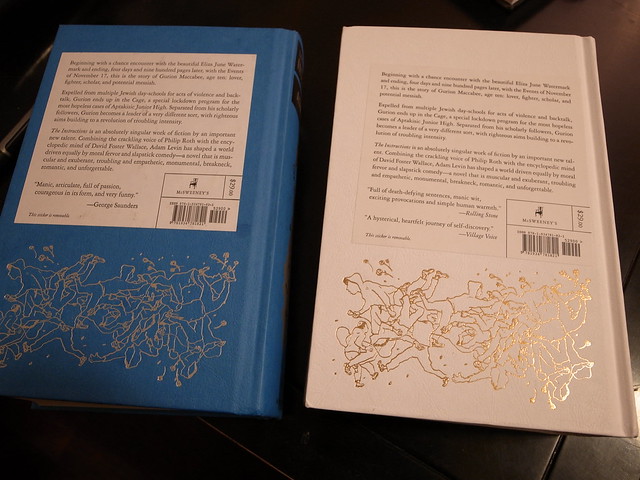
And the hacking began.

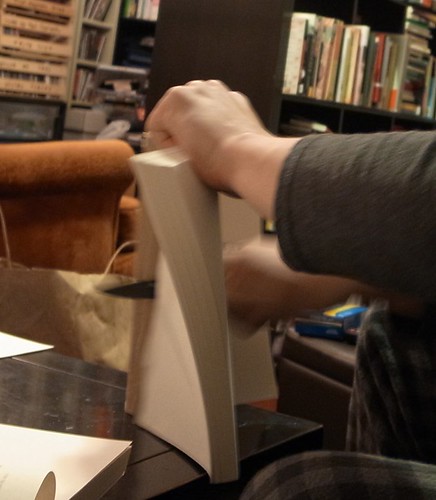
I first cut the book from its hardcover, and found suitable chapter ends with which to cut the book. Now in five digestible tomes, I can cart the book in fragments.
As I cut into the literary flesh I was reminded of El Gaviero who, in one of his earlier adventures – perhaps “The Snow of the Admiral” – also brought along only tattered fragments of greater books due to size and space. I also drew inspiration from the recent reading of Skippy Dies; the edition I read was spliced across three paperbacks housed in a handsome box, making it ever the easier book to transport. A similar appreciation was felt for the same version of 2666.
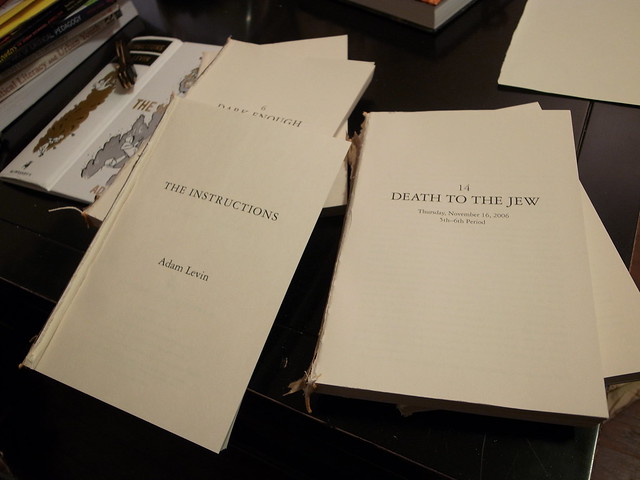
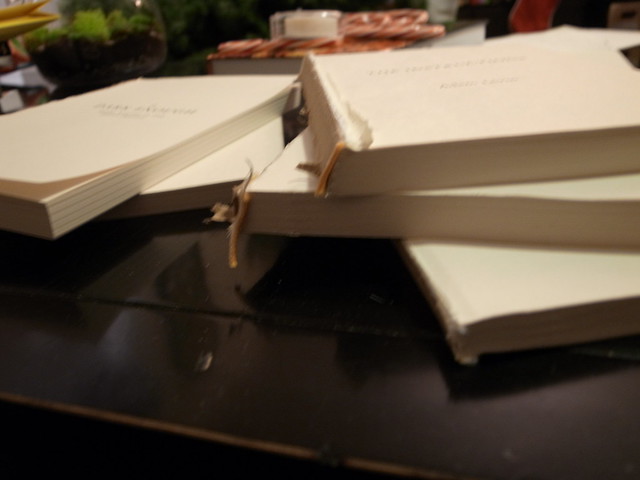
Finally, searching for the appropriate places in the text to sever text from text, to create neat piles of books, I scanned the top to see if cutting specific signatures of the book would be feasible. This did not meet my preference for separations at the end of chapters so didn’t pan out. However, I was reminded – in tracing this line of thinking – of a fragment of a literary anecdote: while doing an undergraduate fellowship at the Clarke Library, I was shown a book that was unique in the library not for its content than for its state of being. As one of the foremost collections of books by, from, or related to Oscar Wilde, the book in question (though its name is of course lost to the ineptitude of youthful obliviousness) was a gift from Wilde to his lover at the time. However, after receiving the book, Wilde’s companion rejected Wilde. The book, now owned by the Clarke Library is a treasure in that the top signatures of the book were never cut; the pages could not be opened without these being cut. The book is an artifact of a relationship run stale; Wilde’s gift nothing more than a weighty reminder of a past romance, nothing to be consumed or to even pretend to have opened.
But then comes the spinsterish head of academia: I believe a researcher expressed an interest in reading this particular copy of the Clarke’s collection. Does the library cut open the book for the needs of academia? Or preserve the book’s unrelinquished secrets in the spirit of historical veracity? Honestly, I don’t remember what decisions were made. The story itself comes as little more than a literary reverie.
A diversion, I realize, but one that brings me back to pure fascination of books in their dusty, hefty, and sometimes unwieldy physicality.
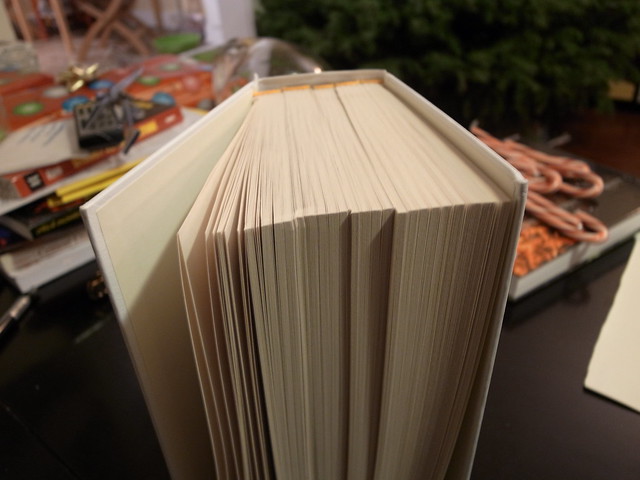
So weird how this conversation keeps coming up as of late I’m my recently limited circle of family, friends, colleagues, students…. Attending hospital staff.
Maybe it is the holiday fever for big ticket tech items… Or my own personal fear of the extinction of printed literature. Either way this post makes me happy.
Brilliant rubbish
I am currently trying to solve an inner conflict with myself. I can not, for the life of me decide whether you are a genius for being able to find a way in which to transport that monster of a book you’re reading (that looks extremely interesting, might I add,) yet, I find myself wanting to strangle you for not only defacing a published work, but because you went about it so meticulously and to top it off found a way to torture someone (that someone being me) by posting up your step by step pictures. What’s really killing me now though is how badly I want to deface a book like that. Let me know how great it feels when you finish all the parts.
The other day I deliberated for some time whether I buy the e-version of a particular book for my iPad- where I can virtually highlight sections w my finger, leave margin notes that are indexed automatically, check the meaning of words on the fly with the built in dictionary (a feature i use more often than I feel comfortable admitting), and easily cut and paste compelling quotes into my synced Evernote folder -, or the old school book, which has style, weight and a certain tactile charm. I decided on both, which costs something like 40 bucks
If I recall correctly, the Clark Library argued something to the effect of, “we’re a library and not a museum. the point of having the books is to study its literary contents. Yes, the book itself and how it was made offers interesting historical information, but the intellectual factor outweighs the romantic notion of the book as an object.” And then they cut the signatures. I would not have. But that’s because I’m superficial, unapologetically judge books by their covers and appreciate them as objects as much as the contents.
Your mutilation of this hardcover–pressed, foiled and beautifully designed–was not quite as heartbreaking as watching the water turn blood red in The Cove, but a close second place since you did not completely murder the book and at least put it back together all Frankenstein-like.
Pingback: The American Crawl : There is Damage: On Finishing the Instructions
Pingback: The American Crawl : Productivity and Unhinging Ideas From Books: A Collaborative Post with Jason Sellers (Part I)